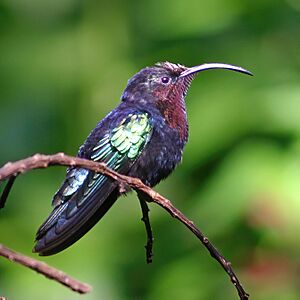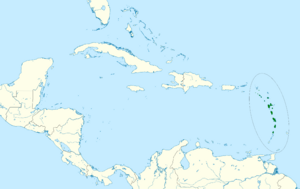Purple-throated carib facts for kids
The purple-throated carib (Eulampis jugularis) is a beautiful hummingbird that lives on many islands in the Lesser Antilles. These islands are a group of small islands in the Caribbean Sea. This amazing bird is known for its bright, fiery purple-red throat and chest. It's a resident bird, meaning it stays in these areas all year round. Sometimes, it might fly to other islands further north or south, but that's not common.
Quick facts for kids Purple-throated carib |
|
|---|---|
 |
|
| Purple-throated carib in Morne Diablotins National Park, Dominica | |
| Conservation status | |
| Scientific classification | |
| Genus: |
Eulampis
|
| Species: |
jugularis
|
 |
|
| Synonyms | |
|
Trochilus jugularis Linnaeus, 1766 |
|
Contents
About Its Name
Scientists give every living thing a special name. This helps everyone know exactly which animal they are talking about. The purple-throated carib was first officially described in 1766 by a Swedish scientist named Carl Linnaeus.
He gave it the scientific name Trochilus jugularis. The word jugularis is an old Latin word that means "of the throat." This makes sense because of the bird's bright throat color! Later, in 1831, another scientist named Friedrich Boie put this hummingbird into a group called Eulampis. It shares this group with another bird, the green-throated carib.
What It Looks Like
The purple-throated carib is about 11 to 12 centimeters (4.3 to 4.7 inches) long. Male birds usually weigh between 9 and 12 grams (0.32 to 0.42 ounces). Females are a little lighter, weighing 7 to 10 grams (0.25 to 0.35 ounces).
Both male and female adult birds look very similar. Their head and back are a soft, velvety black color. Their throat and chest are a striking, fiery purplish-red. Their wings shine with a bright golden-green color. The tail and the feathers covering it are a metallic greenish-blue.
Beak Shape
Male purple-throated caribs have a beak that is medium-long and curves slightly downwards. The female's beak is even longer and curves more strongly. Young birds have an orange throat and chest with small red spots.
Where It Lives
The purple-throated carib lives all the time on several islands. These include Antigua, Dominica, Guadeloupe, Martinique, Montserrat, Saba, Saint Kitts and Nevis, Saint Lucia, Saint Vincent, and Sint Eustatius.
Sometimes, these birds might fly to other islands like Barbados, Barbuda, Grenada, or the Greater Antilles. However, they don't usually stay there. They prefer to live inside and along the edges of thick forests. You can usually find them at heights between 800 and 1200 meters (2,600 to 3,900 feet) above sea level.
How It Behaves
Movement
Purple-throated caribs generally stay in one place. They don't usually migrate or fly long distances. However, on the islands of St. Lucia and St. Vincent, they have been seen closer to the sea in late May.
What It Eats
This hummingbird mainly sips nectar from flowering trees. They look for food from the middle parts of the trees all the way up to the very top. Male birds will protect areas with flowers all year round. Female birds also protect these feeding spots when they are not raising young.
They also eat small insects and spiders. They catch these tiny creatures while flying or pick them off leaves, flowers, and spider webs.
Life Cycle and Reproduction
Purple-throated caribs usually build their nests and lay eggs between February and May. Sometimes, this season can start as early as January or last until September.
They make a small, cup-shaped nest. It's built from soft plant fibers and spider silk. Sometimes, they add small pieces of lichen and bark to the outside of the nest. They attach their nest to a tree branch that stands straight up, usually about 3 to 5 meters (10 to 16 feet) above the ground. Female birds are very protective of their nests.
A female bird usually lays two eggs. The eggs hatch after about 17 to 19 days. The young birds are ready to fly out of the nest about 17 to 20 days after they hatch.
Sounds It Makes
The purple-throated carib makes loud "tsip" and sharp "chewp" sounds. They repeat these calls very quickly when they are upset or excited.
Its Conservation Status
The IUCN (International Union for Conservation of Nature) says that the purple-throated carib is a species of "Least Concern." This means that scientists are not worried about it becoming endangered right now. We don't know exactly how many of these birds there are, or if their numbers are growing or shrinking.
Even though they only live on a chain of small islands, they are quite common in the areas where they prefer to live. They can also live in places changed by humans, which means losing their natural home is probably not a big problem for them.


